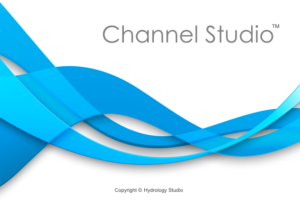Scour is the result of the erosive action of flowing water that excavates and carries away bed material from the banks of streams and from around objects like bridge piers. Different bed materials scour at different rates. Loose granular soils are rapidly eroded by flowing water, while cohesive soils are more scour-resistant. Scour should always be evaluated at bridge crossings, especially during a multi-disciplined design to determine if scour is a critical factor in the structural design.
Channel Studio evaluates both Contraction and Pier scour. All that is needed from the user is the bed material, D50 (the median diameter of the bed material, diameter which 50% of the sizes are smaller) and a selection of the pier nose shape. Channel Studio takes care of the rest using methodologies from Hydraulic Engineering Circular No. 18 and HEC-RAS. Detailed calculation procedures are described in “Computational Methods“.

Contraction Scour
Contraction scour at a bridge crossing involves the removal of material from the bed and banks across all or most of the channel width. This component of scour results from a contraction of the flow area at the bridge which causes an increase in velocity and shear stress on the bed through the bridge. The contraction is typically caused by the bridge itself by narrowing the stream channel width.
Based on the continuity principle, (Q = VA) a decrease in flow area (A) results in an increase in average velocity (V). This increases erosive forces in the contraction and more material is removed from the contracted reach than is transported into the reach. The quantity of transported bed material from the reach lowers the original bed elevation. But as the bed elevation is lowered, the flow area increases, reducing the velocity until finally equilibrium is reached and no more sediment is transported out. This ultimate depth is computed as Contraction scour.
Critical Velocity
The velocity at which bed material will begin to transport is called Critical Velocity. Some typical critical velocities are listed below.

Pier Scour
Pier scour, also known as local scour, refers to the erosion of material surrounding piers. This phenomenon occurs due to the acceleration of water flow and the vortices created by the pier obstructing the flow. The primary factors influencing local pier scour include the velocity and depth of the water just upstream of the pier, along with the pier’s projected shape. These measurements are taken from the upstream, approaching cross-section.

Channel Studio evaluates and computes scour for each individual pier. The approaching velocity and depth, y1, is that of the Left Overbank, Main Channel or Right Overbank; depending on where the individual pier is located.
HEC-18 indicates that while local scour at piers has been thoroughly investigated in laboratory settings, there is a scarcity of field data, and most studies have focused on basic pier designs. Consequently, the software’s assessments are restricted to single-shaft piers, with the assumption that all piers within a given section share the same geometric configuration, whether rounded, rectangular, or sharp-nosed triangular.
Abutment Scour
There are significant gaps in knowledge and general understanding of abutment scour at bridge crossings. The problem is that little field data on abutment scour exist and because of this, abutment scour is not offered in the current version of this software.
